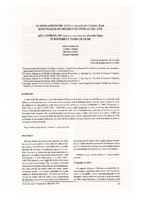Acodos aéreos de Gleditsia amorphoides (Griseb) Taub. efectuados en diferentes épocas del año
Air layering of Gleditsia amorphoides (Griseb) Taub. in different times of year
Date
2007-12-01Author
Calabroni de Asseph, Alicia
Cánepa, Lilians Noemí
Godoy, Marcela
Pernochi, Lorena Soledad
Metadata
Show full item recordAbstract
En este trabajo se evalúan las respuestas de plantas juveniles de cuatro y cinco años de edad a acodos aéreos, con diferentes concentraciones y combinaciones de auxinas y en diferentes épocas del año. Para favorecer la inducción de raíces caulinares se procedió a la aplicación de tres tratamientos (1: AIB 5000 p.p.m.; 2: AIA 5000 p.p.m. y 3: ANA 2500 - AIB 2500 p.p.m.), y un fungicida sobre ramas basales, y experiencias testigo. Diez fenotipos diferentes fueron seleccionados para cada uno de los tratamientos, cada uno de los cuales contó con cinco repeticiones por planta. La variable estudiada fue el porcentaje de acodos enraizados. En otoño de 2000, en plantas de cuatro años de edad y tras la aplicación de diferentes concentraciones auxínicas se detectó la respuesta más favorable a los acodos aéreos efectuados. El coeficiente de correlación de Pearson mostró que las temperaturas medias mensuales influenciaron favorablemente la formación de raíces caulógenas. In this work the answers of youthful plants of four and five years of age to aerial layers are evaluated, with different concentrations and combinations from auxinas and at different times from the year. In order to favor the induction by adventitiuos roots was come to the application of three treatments (1: 5000 AIB p.p.m.; 2: 5000 AIA p.p.m. and 3: ANA 2500 – AIB 2500 p.p.m.), and a fungicide on basal branches, and experiences witness. Ten different phenotypes were selected for each one of the treatments, each one of which counted on five repetitions by plant. The studied variable was the percentage of taken root layers. In autumn of 2000, in plants of four years of age and after the most favorable answer to the conducted aerial layers was detected. The coefficient of correlation of Pearson showed that the monthly average temperatures influenced the formation by caulogenas roots favorably.
Collections
- Revista Yvyraretá [351]
The following license files are associated with this item:




